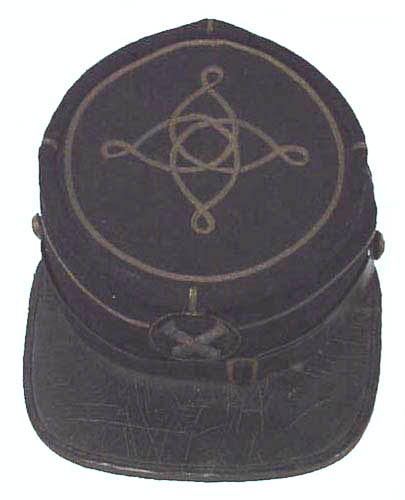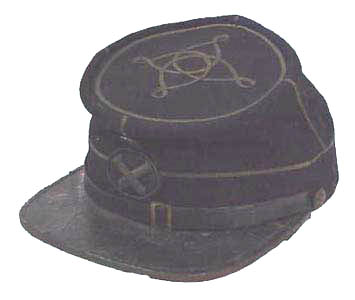Officer's Headgear

Chasseur Type Forage Cap of
Captain William Hawley 9th New York Heavy Artillery

 The characteristic feature of the Chasseur type forage cap (kepi)
was a lower cut to the sides that resulted in a cap
that did not flop forward on the brim as much. In many cases, the kepi also had decorative gold or black silk braid on the cardinal
points of the sides and forming a trefoil on the crown, as did this example. The extra braid was offered in the Schuyler,
Hartley and Graham catalog, but is not mentioned in the 1861 Regulations. A small embroidered crossed cannons on black
velvet, surrounded by an oval of Jaceron wire and surmounted by a small metallic number nine comprise the insignia.
The characteristic feature of the Chasseur type forage cap (kepi)
was a lower cut to the sides that resulted in a cap
that did not flop forward on the brim as much. In many cases, the kepi also had decorative gold or black silk braid on the cardinal
points of the sides and forming a trefoil on the crown, as did this example. The extra braid was offered in the Schuyler,
Hartley and Graham catalog, but is not mentioned in the 1861 Regulations. A small embroidered crossed cannons on black
velvet, surrounded by an oval of Jaceron wire and surmounted by a small metallic number nine comprise the insignia.
William Hawley joined at age 42 in August 1862 as a first lieutenant.
He was promoted to captain of Company E, 9th New York Heavy Artillery. Heavy artillery units served in the defenses of
Washington and led the fairly comfortable life of garrison soldiers. This all changed on May 18, 1864, when U.S. Grant
received permission to draw on the garrison soldiers to fill the ranks of the Army of the Potomac and the 9th was assigned
to the third division of the 6th Army Corps. William Hawley was wounded and captured at the battle of Monocacy. His wounds resulted in his discharge from the service.